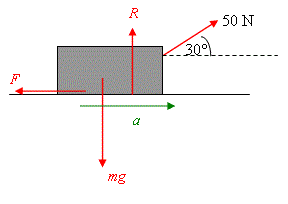Processing Math: Done
Solution 10.5
From Mechanics
We have drawn all the forces acting on the block in the figure. The acceleration is represented by the vector
Applying Newton´s Second Law
 : 50cos30
: 50cos30 −F=maF=50cos30
−F=maF=50cos30 −ma=50
−ma=50 0.866−20
0.866−20 0
0 5=43.3−10=33.3 N
5=43.3−10=33.3 N
We now use the friction condition  R
R
Note that
 : R+50sin30
: R+50sin30 −mg=0R=mg−50sin30
−mg=0R=mg−50sin30 =20
=20 9.81−50
9.81−50 21=196.2−25=171.2 N
21=196.2−25=171.2 N
Using the friction equation gives
 171.2
171.2 =33.3171.2=0.195
=33.3171.2=0.195

